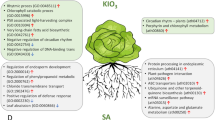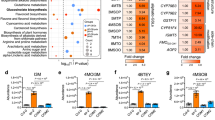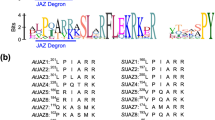Abstract
Jasmonic acid (JA) is a fatty acid-derived signaling molecule that regulates a broad range of plant defense responses against herbivores and some microbial pathogens. Molecular genetic studies have established that JA also performs a critical role in several aspects of plant development. Here, we describe the characterization of the Arabidopsis mutant jasmonic acid-hypersensitive1-1 (jah1-1), which is defective in several aspects of JA responses. Although the mutant exhibits increased sensitivity to JA in root growth inhibition, it shows decreased expression of JA-inducible defense genes and reduced resistance to the necrotrophic fungus Botrytis cinerea . Gene cloning studies indicate that these defects are caused by a mutation in the cytochrome P450 protein CYP82C2. We provide evidence showing that the compromised resistance of the jah1-1 mutant to B . cinerea is accompanied by decreased expression of JA-induced defense genes and reduced accumulation of JA-induced indole glucosinolates (IGs). Conversely, the enhanced resistance to B. cinerea in CYP82C2-overexpressing plants is accompanied by increased expression of JA-induced defense genes and elevated levels of JA-induced IGs. We demonstrate that CYP82C2 affects JA-induced accumulation of the IG biosynthetic precursor tryptophan (Trp), but not the JA-induced IAA or pathogen-induced camalexin. Together, our results support a hypothesis that CYP82C2 may act in the metabolism of Trp-derived secondary metabolites under conditions in which JA levels are elevated. The jah1-1 mutant should thus be important in future studies toward understanding the mechanisms underlying the complexity of JA-mediated differential responses, which are important for plants to adapt their growth to the ever-changing environments.
Similar content being viewed by others
Log in or create a free account to read this content
Gain free access to this article, as well as selected content from this journal and more on nature.com
or
References
Creelman RA, Mullet JE . Biosynthesis and action of jasmonates in plants. Annu Rev Plant Physiol Plant Mol Biol 1997; 48:355–381.
Turner JG, Ellis C, Devoto A . The jasmonate signal pathway. Plant Cell 2002; 14:S153–S164.
Browse J . Jasmonate: an oxylipin signal with many roles in plants. Vitam Horm 2005; 72:431–456.
Wasternack C . Jasmonates: an update on biosynthesis, signal transduction and action in plant stress response, growth and development. Ann Bot 2007; 100:681–697.
Howe GA, Jander G . Plant immunity to insect herbivores. Annu Rev Plant Biol 2008; 59:41–66.
Ueda J, Kato J . Isolation and identification of a senescence-promoting substance from wormwood (Artemisia absinthium L.). Plant Physiol 1980; 66:246–249.
Staswick PE, Su WP, Howell SH . Methyl jasmonate inhibition of root-growth and induction of a leaf protein are decreased in an Arabidopsis thaliana mutant. Proc Natl Acad Sci USA 1992; 89:6837–6840.
Feys BJF, Benedetti CE, Penfold CN, Turner JG . Arabidopsis mutants selected for resistance to the phytotoxin coronatine are male-sterile, insensitive to methyl jasmonate, and resistant to a bacterial pathogen. Plant Cell 1994; 6:751–759.
Xie DX, Feys BF, James S, Nieto-Rostro M, Turner JG . COI1: an Arabidopsis gene required for jasmonate-regulated defense and fertility. Science 1998; 280:1091–1094.
Devoto A, Nieto-Rostro M, Xie D, et al. COI1 links jasmonate signaling and fertility to the SCF ubiquitin-ligase complex in Arabidopsis. Plant J 2002; 32:457–466.
Yan J, Zhang C, Gu M, et al. The Arabidopsis CORONATINE INSENSITIVE1 protein is a jasmonate receptor. Plant Cell 2009; 21:2220–2236.
Berger S, Bell E, Mullet JE . Two methyl jasmonate-insensitive mutants show altered expression of AtVsp in response to methyl jasmonate and wounding. Plant Physiol 1996; 111:525–531.
Lorenzo O, Chico JM, Sanchez-Serrano JJ, Solano R . JASMONATE-INSENSIVE1 encodes a MYC transcription factor essential to discriminate between different jasmonate-regulated defense responses in Arabidopsis. Plant Cell 2004; 16:1938–1950.
Staswick PE, Tiryaki I . The oxylipin signal jasmonic acid is activated by an enzyme that conjugates it to isoleucine in Arabidopsis. Plant Cell 2004; 16:2117–2127.
Katsir L, Schilmiller AL, Staswick PE, He SY, Howe GA . COI1 is a critical component of a receptor for jasmonate and the bacterial virulence factor coronatine. Proc Natl Acad Sci USA 2008; 105:7100–7105.
Fonseca S, Chini A, Hamberg M, et al. (+)-7-iso-Jasmonoyl-L-isoleucine is the endogenous bioactive jasmonate. Nat Chem Biol 2009; 5:344–350.
Dombrecht B, Xue GP, Sprague SJ, et al. MYC2 differentially modulates diverse jasmonate-dependent functions in Arabidopsis. Plant Cell 2007; 19:2225–2245.
Chini A, Fonseca S, Fernandez G, et al. The JAZ family of repressors is the missing link in jasmonate signaling. Nature 2007; 448:666–671.
Thines B, Katsir L, Melotto M, et al. JAZ repressor proteins are targets of the SCFCOI1complex during jasmonate signaling. Nature 2007; 448:661–665.
Glazebrook J . Contrasting mechanisms of defense against biotrophic and necrotrophic pathogens. Annu Rev Phytopathol 2005; 43:205–227.
Penninckx IAMA, Eggermont K, Terras FRG, et al. Pathogen-induced systemic activation of a plant defensin gene in Arabidopsis follows a salicylic acid-independent pathway. Plant Cell 1996; 8:2309–2323.
Penninckx IAMA, Thomma BPHJ, Buchala A, Metraux JP, Broekaert WF . Concomitant activation of jasmonate and ethylene response pathways is required for induction of a plant defensin gene in Arabidopsis. Plant Cell 1998; 10:2103–2113.
Epple P, Apel K, Bohlmann H . An Arabidopsis thaliana thionin gene is inducible via a signal transduction pathway different from that for pathogenesis-related proteins. Plant Physiol 1995; 109:813–820.
Staswick PE, Yuen GY, Lehman CC . Jasmonate signaling mutants of Arabidopsis are susceptible to the soil fungus Pythium irregulare. Plant J 1998; 15:747–754.
Thomma BPHJ, Eggermont K, Tierens KFMJ, Broekaert WF . Requirement of functional ethylene-insensitive 2 gene for efficient resistance of Arabidopsis to infection by Botrytis cinerea. Plant Physiol 1999; 121:1093–1102.
Ellis C, Turner JG . The Arabidopsis mutant cev1 has constitutively active jasmonate and ethylene signal pathways and enhanced resistance to pathogens. Plant Cell 2001; 13:1025–1033.
Mikkelsen MD, Petersen BL, Glawischnig E, Jensen AB, Andreasson E, Halkier BA . Modulation of CYP79 genes and glucosinolate profiles in Arabidopsis by defense signaling pathways. Plant Physiol 2003; 131:298–308.
Bednarek P, Pislewska-Bednarek M, Svatos A, et al. A glucosinolate metabolism pathway in living plant cells mediates broad-spectrum antifungal defense. Science 2009; 323: 101–106.
Clay NK, Adio AM, Denoux C, Jander G, Ausubel FM . Glucosinolate metabolites required for an Arabidopsis innate immune response. Science 2009; 323: 95–101.
Wittstock U, Halkier BA . Glucosinolate research in the Arabidopsis era. Trends Plant Sci 2002; 7:263–270.
Grubb CD, Abel S . Glucosinolate metabolism and its control. Trends Plant Sci 2006; 11:89–100.
Halkier BA, Gershenzon J . Biology and biochemistry of glucosinolates. Annu Rev Plant Biol 2006; 57:303–333.
Bodnaryk RP . Potent effect of jasmonates on indole glucosinolates in oilseed rape and mustard. Phytochemistry 1994; 35:301–305.
Doughty KJ, Kiddle GA, Pye BJ, Wallsgrove RM, Pickett JA . Selective induction of glucosinolates in oilseed rape leaves by methyl jasmonate. Phytochemistry 1995; 38:347–350.
Brader G, Tas E, Palva ET . Jasmonate-dependent induction of indole glucosinolates in Arabidopsis by culture filtrates of the nonspecific pathogen Erwinia carotovora. Plant Physiol 2001; 126:849–860.
Sasaki-Sekimoto Y, Taki N, Obayashi T, et al. Coordinated activation of metabolic pathways for antioxidants and defence compounds by jasmonates and their roles in stress tolerance in Arabidopsis. Plant J 2005; 44:653–668.
Zhang J, Xu JX, Kong YZ, et al. Generation of chemical-inducible activation tagging T-DNA insertion lines of Arabidopsis thaliana. Acta Genet Sin 2005; 32:1082–1088.
Boter M, Ruiz-Rivero O, Abdeen A, Prat S . Conserved MYC transcription factors play a key role in jasmonate signaling both in tomato and Arabidopsis. Genes Dev 2004; 18:1577–1591.
Vignutelli A, Wasternack C, Apel K, Bohlmann H . Systemic and local induction of an Arabidopsis thionin gene by wounding and pathogens. Plant J 1998; 14:285–295.
Berger S, Bell E, Sadka A, Mullet JE . Arabidopsis thaliana Atvsp is homologous to soybean VspA and VspB, genes encoding vegetative storage protein acid-phosphatases, and is regulated similarly by methyl jasmonate, wounding, sugars, light and phosphate. Plant Mol Biol 1995; 27:933–942.
Bell E, Creelman RA, Mullet JE . A chloroplast lipoxygenase is required for wound-induced jasmonic acid accumulation in Arabidopsis. Proc Natl Acad Sci USA 1995; 92:8675–8679.
Rupasinghe S, Schuler MA . Homology modeling of plant P450s. Phytochem Rev 2006; 5:473–505.
Xu L, Liu F, Lechner E, et al. The SCF (COI1) ubiquitin-ligase complexes are required for jasmonate response in Arabidopsis. Plant Cell 2002; 14:1919–1935.
Nelson DR, Schuler MA, Paquette SM, Werck-Reichhart D, Bak S . Comparative genomics of rice and Arabidopsis . Analysis of 727 cytochrome P450 genes and pseudogenes from a monocot and a dicot. Plant Physiol 2004; 135:756–772.
Frank MR, Deyneka JM, Schuler MA . Cloning of wound-induced cytochrome P450 monooxygenases expressed in pea. Plant Physiol 1996; 110:1035–1046.
Schopfer CR, Ebel J . Identification of elicitor-induced cytochrome P450s of soybean (Glycine max L.) using differential display of mRNA. Mol Gen Genet 1998; 258:315–322.
Ralston L, Kwon ST, Schoenbeck M, et al. Cloning, heterologous expression, and functional characterization of 5-epi-aristolochene-1,3-dihydroxylase from tobacco (Nicotiana tabacum). Arch Biochem Biophys 2001; 393:222–235.
Siminszky B, Gavilano L, Bowen SW, Dewey RE . Conversion of nicotine to nornicotine in Nicotiana tabacum is mediated by CYP82E4, a cytochrome P450 monooxygenase. Proc Natl Acad Sci USA 2005; 102:14919–14924.
Radwanski ER, Last RL . Tryptophan biosynthesis and metabolism: biochemical and molecular genetics. Plant Cell 1995; 7:921–934.
Zhao Y, Hull AK, Gupta NR, et al. Trp-dependent auxin biosynthesis in Arabidopsis: involvement of cytochrome P450s CYP79B2 and CYP79B3. Genes Dev 2002; 16:3100–3112.
Hansen BG, Halkier BA . New insight into the biosynthesis and regulation of indole compounds in Arabidopsis thaliana. Planta 2005; 221:603–606.
Sugawara S, Hishiyama S, Jikumaru Y, et al. Biochemical analyses of indole-3-acetaldoxime-dependent auxin biosynthesis in Arabidopsis. Proc Natl Acad Sci USA 2009; 106:5430–5435.
Celenza JL, Quiel JA, Smolen GA, et al. The Arabidopsis ATR1 Myb transcription factor controls indolic glucosinolate homeostasis. Plant Physiol 2005; 137:253–262.
Barlier I, Kowalczyk M, Marchant A, et al. The SUR2 gene of Arabidopsis thaliana encodes the cytochrome P450 CYP83B1, a modulator of auxin homeostasis. Proc Natl Acad Sci USA 2000; 97:14819–14824.
Bak S, Tax FE, Feldmann KA, Galbraith DW, Feyereisen R . CYP83B1, a cytochrome P450 at the metabolic branch point in auxin and indole glucosinolate biosynthesis in Arabidopsis thaliana. Plant Cell 2001; 12:101–111.
Mikkelsen MD, Naur P, Halkier BA . Arabidopsis mutants in the C-S lyase of glucosinolate biosynthesis establish a critical role for indole-3-acetaldoxime in auxin homeostasis. Plant J 2004; 37:770–777.
Zhou N, Tootle TL, Glazebrook J . Arabidopsis PAD3, a gene required for camalexin biosynthesis, encodes a putative cytochrome P450 monooxygenase. Plant Cell 1999; 11:2419–2428.
Xu L, Liu F, Wang Z, et al. An Arabidopsis mutant cex1 exhibits constant accumulation of jasmonate-regulated AtVSP, Thi2.1 and PDF1.2. FEBS Lett 2001; 494:161–164.
Stintzi A, Weber H, Reymond P, Browse J, Farmer EE . Plant defense in the absence of jasmonic acid: the role of cyclopentenones. Proc Natl Acad Sci USA 2001; 98:12837–12842.
Devoto A, Ellis C, Magusin A, et al. Expression profiling reveals COI1 to be a key regulator of genes involved in wound- and methyl JA-induced secondary metabolism, defence, and hormone interactions. Plant Mol Biol 2005; 58:497–513.
Taki N, Sasaki-Sekimoto Y, Obayashi T, et al. 12-Oxo-phytodienoic acid triggers expression of a distinct set of genes and plays a role in wound-induced gene expression in Arabidopsis. Plant Physiol 2005; 139:1268–1283.
Grant MR, Jones JDG . Hormone (dis)harmony moulds plant health and disease. Science 2009; 324:750–752.
Mewis I, Appel HM, Hom A, Raina R, Schultz JC . Major signaling pathways modulate Arabidopsis glucosinolate accumulation and response to both phloem-feeding and chewing insects. Plant Physiol 2005; 138:1149–1162.
Ehlting J, Sauveplane V, Olry A, Ginglinger JF, Provart NJ, Werck-Reichhart D . An extensive (co-)expression analysis tool for the cytochrome P450 superfamily in Arabidopsis thaliana. BMC Plant Biol 2008; 8:47.
Boerjan W, Cervera MT, Delarue M, et al. Superroot, a recessive mutation in Arabidopsis, confers auxin overproduction. Plant Cell 1995; 7:1405–1419.
Grubb CD, Zipp BJ, Ludwig-Muller J, Masuno MN, Molinski TF, Abel S . Arabidopsis glucosyltransferase UGT74B1 functions in glucosinolate biosynthesis and auxin homeostasis. Plant J 2004; 40:893–908.
Yanofsky C, Horn V . Role of regulatory features of the trp operon of Escherichia coli in mediating a response to a nutritional shift. J Bacteriol 1994; 176:6245–6254.
Kreps JA, Ponappa T, Dong W, Town CD . Molecular basis of alpha-methyltryptophan resistance in amt-1, a mutant of Arabidopsis thaliana with altered tryptophan metabolism. Plant Physiol 1996; 110: 1159–1165.
Li J, Last RL . The Arabidopsis thaliana trp5 mutant has a feedback-resistant anthranilate synthase and elevated soluble tryptophan. Plant Physiol 1996; 110:51–59.
Sun JQ, Xu YX, Ye SQ, et al. Arabidopsis ASA1 is important for jasmonate-mediated regulation of auxin biosynthesis and transport during lateral root formation. Plant Cell 2009; 21:1495–1511.
Thomma BPHJ, Eggermont K, Penninckx IAMA, et al. Separate jasmonate-dependent and salicylate-dependent defense-response pathways in Arabidopsis are essential for resistance to distinct microbial pathogens. Proc Natl Acad Sci USA 1998; 95:15107–15111.
Liu YG, Mitsukawa N, Oosumi T, Whittier RF . Efficient isolation and mapping of Arabidopsis thaliana T-DNA insert junctions by thermal asymmetric interlaced PCR. Plant J 1995; 8:457–463.
Shaw CH . Introduction of cloning plasmids into Agrobacterium tumefaciens. Methods Mol Biol 1995; 49:33–37.
Jefferson RA, Kavanagh TA, Bevan MW . GUS fusions: beta-glucuronidase as a sensitive and versatile gene fusion marker in higher plants. EMBO J 1987; 6:3901–3907.
Koch E, Slusarenko AJ . Arabidopsis is susceptible to infection by a downy mildew fungus. Plant Cell 1990; 2:437–445.
Grubb CD, Gross HB, Chen DL, Abel S . Identification of Arabidopsis mutants with altered glucosinolate profiles based on isothiocyanate bioactivity. Plant Sci 2002; 162:143–152.
Acknowledgements
We gratefully acknowledge Dr Jianru Zuo (Institute of Genetics and Developmental Biology, Chinese Academy of Sciences, China) for providing T-DNA mutagenized population of Arabidopsis, Dr Salomé Prat (Institut de Biologia Molecular de Barcelona, Spain) for providing homozygous atmyc2-2 mutant (T-DNA insertion line SALK_083483) seeds and Dr Jane Glazebrook for assisting with camalexin measurements. This work was supported by grants from the Chinese Academy of Sciences (KSCX2-YW-N-045, KSCX2-YW-N-015), the Ministry of Agriculture of China (2008ZX08009-003-001) and the Ministry of Science and Technology of China (2007CB948201, 2006AA10A116). Work in the laboratory of Jerry D Cohen was supported by grants from the US National Science Foundation (MCB-0725149 and DBI-PGRP-0606666) and the USDA, National Research Initiative (2005-35318-16197).
Author information
Authors and Affiliations
Corresponding author
Additional information
( Supplementary information is linked to the online version of the paper on the Cell Research website.)
Supplementary information
Supplementary information, Figure S1
Root growth of 8-d-old wild-type (WT) and jah1-1 seedlings grown in the absence (control) or presence of 0.5 μM ABA, 1 μM ACC, 50 nM 2,4-D, 100 mM NaCl or 300 mM manntiol. (PDF 310 kb)
Supplementary information, Figure S2
Complementation of the jah1-1 phenotype. (PDF 134 kb)
Supplementary information, Figure S3
Allelic test of the jah1 mutants. (PDF 168 kb)
Supplementary information, Figure S4
Quantification of levels of representative IGs in WT, jah1-1 and OE37 after MeJA treatment. (PDF 151 kb)
Supplementary information, Figure S5
Free IAA measurement of WT, jah1-1 and OE37 in response to MeJA treatment. (PDF 79 kb)
Supplementary information, Figure S6
Accumulation of camalexin in WT, jah1-1, OE37 and pad3 after inoculation with A. brassicicola. (PDF 67 kb)
Supplementary information, Table S1
List of the primers used in this study. (PDF 75 kb)
Supplementary information, Data S1
Materials and Methods (PDF 125 kb)
Rights and permissions
About this article
Cite this article
Liu, F., Jiang, H., Ye, S. et al. The Arabidopsis P450 protein CYP82C2 modulates jasmonate-induced root growth inhibition, defense gene expression and indole glucosinolate biosynthesis. Cell Res 20, 539–552 (2010). https://doi.org/10.1038/cr.2010.36
Received:
Revised:
Accepted:
Published:
Issue date:
DOI: https://doi.org/10.1038/cr.2010.36
Keywords
This article is cited by
-
Overexpression of cucumber CYP82D47 enhances resistance to powdery mildew and Fusarium oxysporum f. sp. cucumerinum
Functional & Integrative Genomics (2024)
-
Identification of the domestication gene GmCYP82C4 underlying the major quantitative trait locus for the seed weight in soybean
Theoretical and Applied Genetics (2024)
-
Identification of genes governing resistance to PCN (Globodera rostochiensis) through transcriptome analysis in Solanum tuberosum
Functional & Integrative Genomics (2023)
-
Transcriptome analysis and differential expression in Arabidopsis thaliana in response to rohitukine (a chromone alkaloid) treatment
Functional & Integrative Genomics (2023)
-
Rice (Oryza sativa L.) cytochrome P450 protein 716A subfamily CYP716A16 regulates disease resistance
BMC Genomics (2022)



